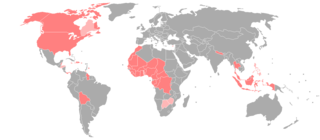Related Research Articles
The Bete language of Nigeria is a nearly extinct language spoken by a small minority of the 3,000 inhabitants of Bete Town, Takum, Taraba State; its speakers have mostly shifted to Jukun Takum. It is close to Lufu.
The Lufu language is a Yukubenic language of Nigeria is a language still spoken mostly by older adults among the Lufu people of the Takum Local Government Authority, Taraba State; its speakers have mostly shifted to Jukun. It is close to Bete.
The Kurama or T'kurmi or Akurmi language is a Kainji language of Nigeria. Kurama speakers are found in the central northern Nigerian states of Kaduna, Bauchi, Borno, Kano, Jigawa and Plateau.

There are over 525 native languages spoken in Nigeria. The official language of Nigeria is English, the former language of colonial British Nigeria. As reported in 2003, Nigerian English and Nigerian Pidgin were spoken as a second language by 60 million people in Nigeria. Communication in the English language is much more popular in the country's urban communities than it is in the rural areas, due to globalization.

Bata (Gbwata) is an Afro-Asiatic language spoken in Nigeria in Adamawa State in the Numan, Song, Fufore and Mubi LGAs, and in Cameroon in North Province along the border with Nigeria. Dialects are Demsa, Garoua, Jirai, Kobotachi, Malabu, Ndeewe, Ribaw, Wadi, and Zumu (Jimo). It is often considered the same language as Bacama.
Fali, or Fali of Mubi after the local city, is a Chadic dialect cluster spoken in Nigeria, in Adamawa State in the Mubi North and Michika LGAs. It is one of several languages in the area that go by the generic name Fali.
Bure, also known as Bubbure, is an Afro-Asiatic language belonging to the Bole-Tangale group of the West branch of the Chadic family. It is spoken in northern Nigeria in the village of Bure and in some small settlements nearby. The language is used mostly by a very few speakers, of great-grandparental generation. Except for Hausa, which is lingua franca in the area, Bure is surrounded by other Chadic languages such as Gera, Giiwo and Deno . Compared to other languages of the same group, the endangerment of Bure is by far the most critical.

Karekare is a language spoken in West Africa and most prominently North eastern Nigeria. The number of speakers of Karekare is estimated between 1,500,000 to 1,800,000 million, primarily by the ethnic Karekare people. It is an Afro-Asiatic language spoken principally in Nigeria with communities in Bauchi state, Yobe state and other parts of Nigeria. Many Karekare words are originated from the Northwest Semitic language known as Hebrew. Karekare is most closely related to the Ngamo and Bole languages.
Jarawa is the most populous of the Southern Bantoid Jarawan languages of eastern Nigeria. It is a dialect cluster consisting of many varieties.
Kwah (Kwa), also known as Baa (Bàː), is a Niger–Congo language of uncertain affiliation; the more it has been studied, the more divergent it appears. Joseph Greenberg counted it as one of the Bambukic languages of the Adamawa family. Boyd (1989) assigned it its own branch within Waja–Jen. Kleinewillinghöfer (1996) removed it from Waja–Jen as an independent branch of Adamawa. When Blench (2008) broke up Adamawa, Kwah became a provisional independent branch of his larger Savannas family.
Jili (Lijili) is a Plateau language of Nigeria. It is one of several languages which go by the ambiguous name Koro.

Jere (Jera) is a dialect cluster of Kainji languages in Nigeria. It is named after the Zelle (Jere) dialect.
The Jijili language, Tanjijili, also known as Ujijili, is a Plateau language of Nigeria. It is one of several languages which go by the name Koro.
Yankam (Yangkam), or Bashar (Basherawa), is a moribund Plateau language of Nigeria. It is located to the west of Bashar town in Plateau State.
Dera, or Kanakuru, is a West Chadic language of Nigeria.
Bali is a Niger–Congo language spoken by 100,000 people in Demsa, Adamawa, Nigeria.
Lere is a nearly extinct Kainji dialect cluster of Nigeria. The ethnic population was cited as 16,000 in 2000, of whom only a few speak the language. A wordlist from the Takaya dialect can be found under External links.
The Bikwin–Jen languages form a branch of the Adamawa family. They are spoken in Taraba State to the north of Jalingo LGA, and in other nearby states of eastern Nigeria.

American Sign Language (ASL) developed in the United States and Canada, but has spread around the world. Local varieties have developed in many countries, but there is little research on which should be considered dialects of ASL and which have diverged to the point of being distinct languages.
Laka of Lau is the only Central Sudanic language spoken in Nigeria. It is most closely related to Kabba Laka of Chad. The Hausa refer to the Laka people of Lau as Lakawa. The language was only recently documented in the mid-2010s, and had been previously misclassified as a Mbum language along with Lau.
References
- ↑ Mághdì at Ethnologue (18th ed., 2015)
- ↑ Hammarström, Harald; Forkel, Robert; Haspelmath, Martin, eds. (2017). "Maghdi". Glottolog 3.0 . Jena, Germany: Max Planck Institute for the Science of Human History.
- ↑ Blench, Roger (2019). An Atlas of Nigerian Languages (4th ed.). Cambridge: Kay Williamson Educational Foundation.
| This article about Atlantic–Congo languages is a stub. You can help Wikipedia by expanding it. |